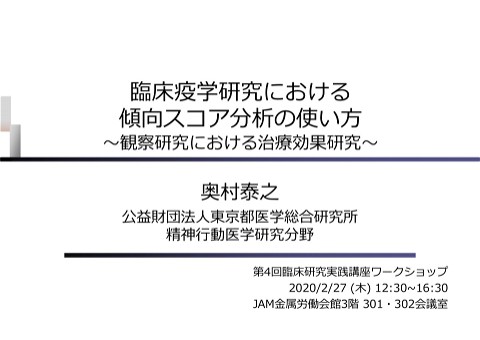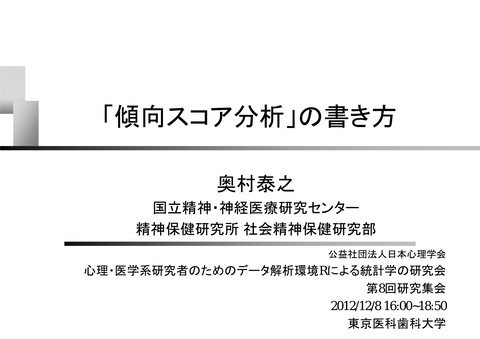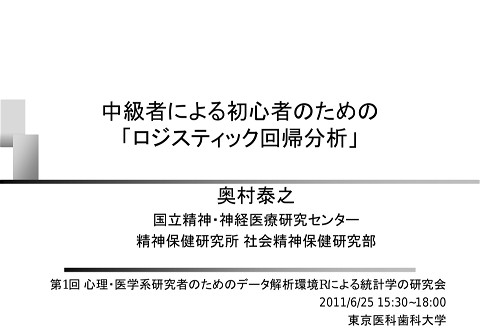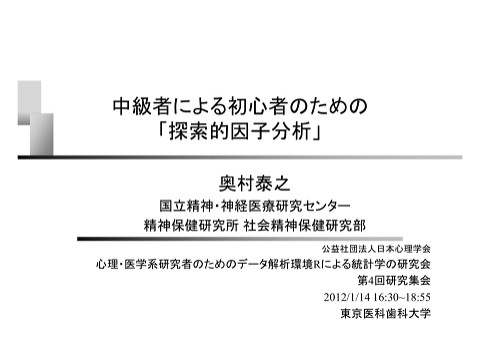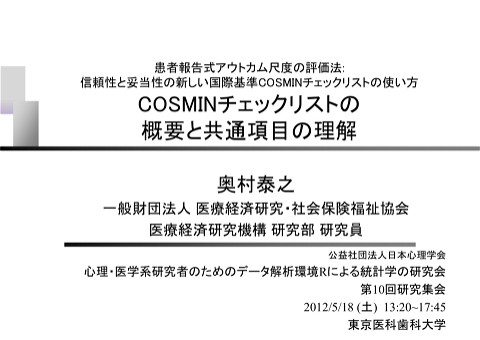傾向スコアの概念とその実践
20.4K Views
May 24, 22
スライド概要
関連スライド
各ページのテキスト
傾向スコアの概念とその実践 奥村泰之 一般財団法人 医療経済研究・社会保険福祉協会 医療経済研究機構 研究部 研究員 第4回臨床研究実践講座ワークショップ 2015/1/23 (金) 13:45~14:30 国立精神・神経医療研究センター 研究所3号館セミナールーム
構成 特徴 共変量の選択 傾向スコアの推定 傾向スコアの利用 バランスの評価 効果の推定 効果の解釈 傾向スコアの実践 2
英語表記 Propensity (Score) Analysis/Methods/Matching Matching Methods 3
変数の役割と尺度水準 1つのアウトカム 量的変数/質的変数/イベント発生までの時間 • 生活の質,生きている/死んでいる,生存時間 1つの割り当て変数 名義尺度 (2水準が中心) • 曝露群/非曝露群 1つ以上の共変量 量的変数/質的変数 共変量 割り当て変数 アウトカム 4
傾向スコア分析の使用目的 アウトカムの測定後に傾向スコア分析を 行い,選択バイアスを減らして,治療の 効果を検討する アウトカムの測定前に傾向スコア分析を 行い,追跡する集団を限定する Stuart EA: Stat Sci 25:1-21, 2010 . 5
事例①測定後 目的 認知症への非定型抗精神病薬と定型薬の死亡リスク アウトカム 抗精神病薬の投与開始後180日以内の全死亡 割り当て変数 非定型薬 vs 定型薬 共変量 認知症重症度,90日前の入院の有無,年齢など Gill SS et al: Ann Intern Med 146:775-86, 2007. 6
事例②測定前 目的 妊娠中のフェノバルビタールによる胎児成長後 の知能 アウトカム 胎児の成長後の知能 割り当て変数 処方あり (33名) vs 処方なし (3308名) 共変量 社会経済的地位,父親の有無など Reinisch JM et al: JAMA 274: 1518-25, 1995. 7
解析の手順 共変量の選択 傾向スコアの推定 反復 傾向スコアの利用 マッチング 重み付け 層化 バランスの評価 効果の推定 効果の解釈 Ali MS et al: J Clin Epidemiol. 2014 Nov 26. pii: S0895-4356(14)00347-3 共変量
報告ガイドライン (赤字は推薦文献) Ali MS et al: Reporting of covariate selection and balance assessment in propensity score analysis is suboptimal: a systematic review (J Clin Epidemiol. 2014) D‘Ascenzo F et al: Use and misuse of multivariable approaches in interventional cardiology studies on drug-eluting stents: a systematic review (J Interv Cardiol. 2012 Dec;25(6):611-21.) Collins GS et al: Comparing treatment effects between propensity scores and randomized controlled trials: improving conduct and reportin (Eur Heart J 33:1867-9, 2012) Gayat E et al: Propensity scores in intensive care and anaesthesiology literature: a systematic review (Intensive Care Med 36: 1993-2003, 2010) Austin PC: A critical appraisal of propensity-score matching in the medical literature between 1996 and 2003 (Stat Med 27:2037-49, 2008) 9
報告ガイドライン (赤字は推薦文献) Austin PC: Primer on statistical interpretation or methods report card on propensity-score matching in the cardiology literature from 2004 to 2006: a systematic review (Circ Cardiovasc Qual Outcomes 1: 62-7, 2008) Austin PC: Propensity-score matching in the cardiovascular surgery literature from 2004 to 2006: a systematic review and suggestions for improvement (J Thorac Cardiovasc Surg 134:1128-35, 2007) Stürmer T et al: A review of the application of propensity score methods yielded increasing use, advantages in specific settings, but not substantially different estimates compared with conventional multivariable methods (J Clin Epidemiol 59: 437-47, 2006) Shah BR et al: Propensity score methods gave similar results to traditional regression modeling in observational studies: a systematic review (J Clin Epidemiol 58: 550-9, 2005) Weitzen S et al: Principles for modeling propensity scores in medical research: a systematic literature review (Pharmacoepidemiol Drug Saf 13: 841-53, 2004) 10
共変量の選択
共変量の適格基準 選択基準 割り当て変数の前/同時に測定された変数 除外基準 アウトカム 中間変数 (割り当て変数により変化しうる変数) 共変量 割り当て変数 アウトカム Austin PC et al: Analysis of observational health care data using SAS (pp51-84). SAS press. 2010. 12
共変量の選択法 先行研究 専門家の意見 統計量 (ステップワイズ法など) 共変量 割り当て変数 Austin PC: Stat Med 27:2037-49, 2008. アウトカム 13
避けるべき共変量 「割り当て変数と強く関連」かつ 「アウトカムと弱く関連」 共変量 アウトカム 割り当て変数 Brookhart MA et al: Am J Epidemiol. 2006 Jun 15;163(12):1149-56. Patrick AR et al: Pharmacoepidemiol Drug Saf. 2011 Jun;20(6):551-9. 14
事例①先行研究 The PS model was estimated using a logistic regression model that adjusted for the patient characteristics listed in Table 1, as well as admissions vital signs and laboratory values (31 variables in total), as these variables were shown to be prognostically significant in other studies [18]. Abrahamyan L et al: Int J Qual Health Care 24:425-32, 2012. 15
事例②専門家の意見 Possible confounders were chosen for their potential association with the outcome of interest based on clinical knowledge. The predicted probability of preprocedural stains was calculated by fitting a logistic regression model, using all clinically relevant variables as shown in Table 1. Ko DT et al: Circ Cardiovasc Qual Outcomes 4:459-66, 2011. 16
事例③統計量 Covariates were carefully selected based on the assumption that none was affected directly by the intervention. Other a priori selected variables were planned for inclusion in the final statistical models. ...(中略)... Variables were considered for inclusion in the final models after calculating correlation coefficients, examining scatterplot matrices, and ensuring that the proportion of missing data was below 20%. Galvagno SM et al: JAMA 307:1602-10, 2012. 17
傾向スコアの推定
傾向スコアとは 正式な理解 観測した共変量が与えられた条件下で,ある 因子に曝露する条件付き確率 直感的な理解 ある人の曝露前の共変量を考慮したときに, ある人が曝露群になる確率 Trojano M et al: Int MS J 16: 90-7, 2009. 19
傾向スコア推定の統計モデル ロジスティック回帰分析 (logistic regression) プロビット回帰分析 (probit regression) 判別分析 (discriminant analysis) 決定木 (classification and regression trees) ニューラルネットワーク (neural networks) 一般化加法モデル (generalized additive models) 多項ロジットモデル (multinomial logistic regression) Austin PC et al: Analysis of observational health care data using SAS (pp51-84). SAS press. 2010. 20
傾向スコア推定の変数役割 従属変数 割り当て変数 (Z) (曝露群/非曝露群) 独立変数 共変量 (X) 傾向スコアの推定値 ( êi ) 予測値: eˆi pr ( z i 曝露群 | xi ) 特徴 得点可能範囲: 0~1 サイズ: 標本サイズと同じ 共変量 (X) 割り当て変数 (Z) 21
事例: ロジスティック回帰分析 Possible confounders were chosen for their potential association with the outcome of interest based on clinical knowledge. The predicted probability of preprocedural stains was calculated by fitting a logistic regression model, using all clinically relevant variables as shown in Table 1. Ko DT et al: Circ Cardiovasc Qual Outcomes 4:459-66, 2011. 22
傾向スコアの利用
傾向スコアの利用法 マッチング (propensity score matching) 重み付け (inverse probability of treatment weighting) 層化 (stratification/subclassification) 共変量 (covariate adjustment) Austin PC: Multivariate Behav Res 46: 399-424, 2011. 24
マッチング法の設定 ①アルゴリズム ②キャリパー ③構成比 ④抽出法 25
アルゴリズムの種類 Greedy matching Nearest neighbor matching Mahalanobis metric matching Optimal matching Guo S, Fraser MW: Propensity score analysis: statistical methods and applications. Sage. 2015. 26
Nearest neighbor matching ①曝露群から無作為に1人選択 ②非曝露群から,①で選択した人の傾向 スコアと,最も類似の傾向スコアの人を ペアとする ③上記の①~②を反復 曝露群の傾向スコア eˆi 0 eˆi 1 非曝露群の傾向スコア Austin PC: Multivariate Behav Res 46: 399-424, 2011. 27
キャリパーの指定 指定法 一定の傾向スコアの距離 (キャリパー) に収ま る人をマッチングの対象とする 推奨値 傾向スコアの推定値をロジット変換した値の 標準偏差に0.2を乗じた値が推奨 Austin PC: Multivariate Behav Res 46: 399-424, 2011. 28
傾向スコア間の距離を確認 ID t1 t2 t3 t4 t5 t6 c1 c2 c3 c4 c5 c6 PS 0.48 0.97 0.69 0.68 0.96 0.34 0.31 0.00 0.74 0.02 0.52 0.29 曝露群 非曝露群 ID PS1 ID PS2 |PS1-PS2| t1 0.48 c5 0.52 0.04 t2 0.97 c3 0.74 0.23 t3 0.69 c1 0.31 0.37 t4 0.68 c6 0.29 0.39 t5 0.96 c4 0.02 0.93 t6 0.34 c2 0.00 0.34 Austin PC: Multivariate Behav Res 46: 399-424, 2011. 一部 距離が大きい 29
一定距離内の人をマッチング ID t1 t2 t3 t4 t5 t6 c1 c2 c3 c4 c5 c6 PS 0.48 0.97 0.69 0.68 0.96 0.34 0.31 0.00 0.74 0.02 0.52 0.29 曝露群 非曝露群 ID PS1 ID PS2 |PS1-PS2| t1 0.48 c1 0.31 0.17 t2 0.97 c3 0.74 0.23 t3 0.69 c5 0.52 0.16 c6 0.29 0.05 距離が0.3以上の 曝露群を除外 t4 0.68 t5 0.96 t6 0.34 Austin PC: Multivariate Behav Res 46: 399-424, 2011. 30
構成比の種類 One-to-one pair matching 1名の曝露群と1名の非曝露群でマッチング Many-to-one (M:1) matching 1名の曝露群とM名の非曝露群でマッチング Full matching 1名の曝露群と複数名の非曝露群,1名の非曝 露群と複数名の曝露群でマッチングの組み合わ せ Austin PC: Multivariate Behav Res 46: 399-424, 2011. 31
Many-to-one (M:1) matching 曝露群1人に,非曝露群を複数 曝露群の傾向スコア eˆi 0 eˆi 1 非曝露群の傾向スコア 32
抽出法の種類 非復元抽出 曝露群のペアとして同一の非曝露群の人を, 複数回使用できない 復元抽出 曝露群のペアとして同一の非曝露群の人を, 複数回使用できる Austin PC: Multivariate Behav Res 46: 399-424, 2011. 33
復元抽出 同一の非曝露群を復元使用 ID t1 t2 t3 t4 t5 t6 c1 c2 c3 c4 c5 c6 PS 0.48 0.97 0.69 0.68 0.96 0.34 0.31 0.00 0.74 0.02 0.52 0.29 曝露群 非曝露群 ID PS1 ID PS2 |PS1-PS2| t1 0.48 c5 0.52 0.04 t2 0.97 c3 0.74 0.23 t3 0.69 c3 0.74 0.06 t4 0.68 c3 0.74 0.07 t5 0.96 c3 0.74 0.21 t6 0.34 c1 0.31 0.03 非曝露群の c3は4回使用 34
事例: nearest neighbor/0.2/4対1/非復元抽出 Propensity matching was then performed according to both bleeding and mortality risk, using the nearest neighbor matching without replacement, with each bleeding patient matched to 4 control patients. A caliper width of 0.2 of the standard deviation of the logit of the propensity score was used for the developed propensity score, (後略) Chhatriwalla AK et al: JAMA. 2013 Mar 13;309(10):1022-9. 35
バランスの評価
バランスの評価法 推奨法 群ごとの要約統計量 標準化差 (standardized difference) QQ plotやside-by-side boxplot 非推奨法 群間の共変量の差異の統計的検定 c統計量 群ごとの傾向スコアの推定値の分布の比較 Austin PC: Multivariate Behav Res 46: 399-424, 2011. 37
標準化差 量的変数 質的変数 特徴 d d M t M c ) sd t2 sd c2 2 pt p c pt (1 pt ) pc (1 pc ) 2 得点可能範囲: -∞ ~ 0 (群間差なし) ~+∞ 0.1未満であればバランスが取れていると判断 dの絶対値に100を乗じる流派もある Austin PC: Multivariate Behav Res 46: 399-424, 2011. 38
バランスが悪いときの対処法 共変量を増やす 共変量間の交互作用項を追加 量的変数の共変量の非線形性を検討 Austin PC: Multivariate Behav Res 46: 399-424, 2011. 39
事例: 要約統計量と標準化差 方法の節 We used a structured iterative approach to refine this logistic regression model to achieve balance of covariates within the matched pairs.29 We used the standardised difference to measure covariate balance, whereby an absolute standardised difference above 10% represents meaningful imbalance.29 結果の節 Individuals who did and did not undergo consultation differed for all measured characteristics (Table 1). Of patients who underwent consultation, 91.6% (n=95 926) were matched to similar patients who did not. The covariate balance in the matched cohort was considerably improved (Table 2). Wijeysundera DN et al: Arch Intern Med 170: 1365-74, 2010. 40
事例: 要約統計量と標準化差 標準化差 群ごとの要約統計量 Wijeysundera DN et al: Arch Intern Med 170: 1365-74, 2010. マッチング後のバランス 41
効果の推定
効果推定の統計モデル 対応を考慮すべきか否か議論がある アウトカム 対応なし[1-2] 対応あり[3-4] 量的変数 独立な2群のt検定 U検定 一般化線形モデル 対応のある2群のt検定 ウィルコクソンの符号順位検定 一般化線形混合モデル 一般化推定方程式 質的変数 χ二乗検定 一般化線形モデル マクネマー検定 AgrestiとMinの方法 条件付きロジスティック回帰分析 一般化線形混合モデル 一般化推定方程式 イベント発生 比例ハザードモデル までの時間 条件付き比例ハザードモデル ロバスト推定 [1] Stuart EA: Stat Med. 2008 May 30;27(12):2062-5;[2] Stuart EA: Stat Sci. 2010 Feb 1;25(1):1-21. [3] Austin PC: Stat Med. 2008 May 30;27(12):2037-49.; [4] Austin PC: Stat Med. 2011 May 20;30(11):1292-301. 43
効果推定の変数役割 従属変数 アウトカム 独立変数 割り当て変数 (Z) (曝露群/非曝露群) 共変量 (X) 割り当て変数 (Z) アウトカム (Y) 共変量 (X) 44
事例: 量的変数/質的変数/対応あり 方法の節 Within the matched pairs, we used the paired t test to compare hospital length of stay and the methods of Agresti and Min28 to compare mortality rates. 結果の節 Within this matched cohort, mean hospital length of stay was significantly shorter among patients who underwent preoperative consultation (8.17 days vs 8.52 days; difference, −0.35 days; 95% confidence interval [CI], −0.27 to −0.43; P < .001). ...(中略)... Consultation was not associated with reduced mortality at either 30 days (relative risk [RR], 1.04; 95% CI, 0.96 to 1.13; P=.36) or 1 year (RR, 0.98; 95% CI, 0.95 to 1.02; P=.20) after surgery. Wijeysundera DN et al: Arch Intern Med 169: 595-602, 2009. 45
効果の解釈
効果の種類 平均因果効果 曝露群の平均因果効果 Schafer JL, Kang J: Psychol Methods 13: 279-313, 2008. 47
平均因果効果 (Average Causal Effect) 母集団の構成員すべてが曝露群から非曝露 群に変化したときの,アウトカムの期待値 の差 ACE E Yi曝露 E Yi非曝露 アウトカム ID 割り当て変数 非曝露 1 曝露 非曝露 因果効果 7.6 6.1 1.5 2 曝露 7.9 7.2 0.7 3 非曝露 4.1 5.2 -1.1 4 曝露 7.1 4.8 2.3 8.3 6.9 1.4 非曝露 N 注) 青色は欠測値 Schafer JL, Kang J: Psychol Methods 13: 279-313, 2008. 48
曝露群の平均因果効果 (Average Treatment effect for Treated) 母集団の構成員のうち曝露群が非曝露群に 変化したときの,アウトカムの期待値の差 ATT E Yi曝露 Z i 曝露 E Yi非曝露 Z i 曝露 アウトカム ID 割り当て変数 曝露 非曝露 1 非曝露 7.6 6.1 2 曝露 7.9 7.2 3 非曝露 4.1 5.2 4 曝露 7.1 4.8 8.3 6.9 非曝露 N 注) 青色は欠測値 Schafer JL, Kang J: Psychol Methods 13: 279-313, 2008. 因果効果 0.7 2.3 49
曝露事例と効果の種類 曝露事例 効果の種類 理由 プライマリケアに受診する喫煙 平均因果効果 喫煙者すべてに冊子を提供すること 者へ禁煙を勧める冊子提供の効 は比較的安価 果 喫煙者への構造化された高強度 曝露群の平均 喫煙者すべてに禁煙プログラムを実 の禁煙プログラムの効果 因果効果 施することは現実的でない Austin PC: Multivariate Behav Res 46: 399-424, 2011. 50
傾向スコアの利用法と効果の種類 利用法 マッチング 重み付け 層化 共変量 平均因果効果 × ○ ○ ○ Austin PC: Multivariate Behav Res 46: 399-424, 2011. 曝露群の平均 因果効果 ○ ○ ○ ○ 51
観測値からの因果効果推定の仮定 ある人の割り当て変数により,他の人の アウトカムの値が変化しない 未測定の共変量はない 統計モデルが正しい ある人は曝露群か非曝露群のいずれかに なり得る (片方の群となる確率が0や1で ない) Schafer JL, Kang J: Psychol Methods 13: 279-313, 2008. 52
傾向スコアの実践
傾向スコアの利用法 [1] Ali MS et al: J Clin Epidemiol. 2014 Nov 26. pii: S0895-4356(14)00347-3 [2] Gayat E et al: Intensive Care Med. 2010 Dec;36(12):1993-2003. 54
曝露群の標本サイズ 研究 第1四分位 中央値 第3四分位 [1] 集中治療 2006-2009 (47編) 121 968 1310 [2] 全体 1983-2003 (177編) 198 635 2247 [3] 全体 2001 (47編) 182 805 3802 [1] Gayat E et al: Intensive Care Med. 2010 Dec;36(12):1993-2003. [2] Stürmer T et al: J Clin Epidemiol. 2006 May;59(5):437-47. [3] Weitzen S et al: Pharmacoepidemiol Drug Saf. 2004 Dec;13(12):841-53. 55
共変量の数 研究 第1四分位 中央値 第3四分位 [1] 集中治療 2006-2009 (47編) 9 15 22 [2] 全体 1983-2003 (177編) 10 17 28 [3] 全体 2001 (47編) 8 17 27 [1] Gayat E et al: Intensive Care Med. 2010 Dec;36(12):1993-2003. [2] Stürmer T et al: J Clin Epidemiol. 2006 May;59(5):437-47. [3] Weitzen S et al: Pharmacoepidemiol Drug Saf. 2004 Dec;13(12):841-53. 56
日本発の論文数増加 (130編) 検索日: 2015/01/12 検索式: (propensity score*[tiab] OR propensity match*[tiab] OR propensity analy*[tiab]) AND (japan*[tiab]) 57
雑誌別の日本発論文数 (130編) 順位 雑誌名 1 2 3 4 5 6 7 8 9 10 11 12 13 14 15 16 17 18 19 20 Circ J Int J Cardiol Cardiovasc Diabetol Eur J Cardiothorac Surg Cardiovasc Interv Ther Clin Ther Crit Care Crit Care Med Eur Heart J Hepatol Res Int J Hematol J Atheroscler Thromb J Cardiol J Gastroenterol J Gastroenterol Hepatol J Thromb Haemost JAMA PLoS One Value Health その他 (1編) 論文数 8 4 3 3 2 2 2 2 2 2 2 2 2 2 2 2 2 2 2 82 58
傾向スコアの将来展望 データベースの整備 未測定の共変量を減らす 欠測発生を予防する 統一ガイドラインの整備 実施と報告のガイドラインが必要 複数の利害関係者により作るべき Borah BJ et al: J Comp Eff Res. 2014 Jan;3(1):63-78. 59
入門書 60
導入論文 [1] Stuart EA: Stat Sci 25:1-21, 2010 . [2] Austin PC: Multivariate Behav Res 46: 399-424, 2011. 61



